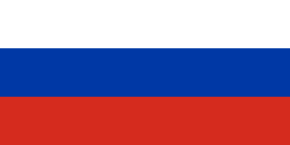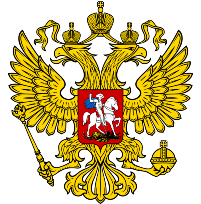|
|
| (34 intermediate revisions by 5 users not shown) |
| Line 1: |
Line 1: |
| {{DISPLAYTITLE:Union of Soviet Socialist Republic}}
| | [[Category: Countries]] |
| {{DISPLAYTITLE:Union of Soviet Socialist Republics}}
| | [[Category:Countries in Europe]] |
| {{NationTemplate | | {{NationTemplate |
| |color=#770b0e | | |color=#183bc7 |
| |title1=USSR | | |title1=Russia |
| |image1= [[File:USSR.png]] | | |image1= [[File:Russianflag.png]] |
| |image2=[[File:USSRcoatofarms.png]] | | |image2=[[File:Russiancoatofarms.png]] |
| |image3=Example | | |image3=Example |
| |full_name=Union Of Soviet Socialist Republics | | |full_name=Russian Federation |
| |national_anthem=[[File:Russiananthem.mp3]] | | |national_anthem=[[File:Russiananthem.mp3]] |
| |motto= За Poccия! | | |motto= За Poccия! |
| |population=11 | | |population=49 |
| |capital_city=Moscow | | |capital_city=Moscow |
| |largest_city=Moscow | | |largest_city=Moscow |
| |oldest_city=Moscow | | |oldest_city=Derbent |
| |formed=1922 | | |formed=1721 |
| |region=Moscow Oblast | | |region=Moscow Oblast |
| |political_system=Socialism, Communism | | |political_system=Authoritarism |
| |leader1name=President of the USSR | | |leader1name=President of the Russian Federation |
| |leader1=Real_Rest | | |leader1=Real_Rest |
| |leader2name=Joe_Mama | | |leader2name=Grutefull |
| |leader2=Deputy Chairman of the USSR | | |leader2=Vice President Of The Russian Federation |
| |economic_system=Capitalism | | |economic_system=Capitalism |
| |language=Russian | | |language=Russian |
| |religion=Christian Orthodox | | |religion=Christian Orthodox |
| |army_size=11 | | |army_size=20 |
| |provinces=East Europe | | |provinces= Moscow-Oblast |
| |part_of=wtf?? | | |part_of= Eurasia |
| |constitution=Socialist Republic | | |constitution=Federation |
| |discord=gfjhdofdsjjfdjfdsjfds | | |discord= https://discord.gg/8vEsJJSSsm |
| }}The '''Soviet Union''', officially the '''Union of Soviet Socialist Republics''' ('''USSR'''), is a transcontinental country that spanned much of Eurasia from 1922 to 1991. The country is a successor state to the Russian Empire; it's nominally a federal union of fifteen national republics, the largest and most populous of which is the Russian SFSR, but in practice both its government and its economy were highly centralized until its final years. As a one-party state governed by the Communist Party of the Soviet Union, it is a flagship communist state. | | }}'''Russia''' (Russian: Россия, <small>romanized:</small> ''Rossiya)'', or the '''Russian Federation''', |
| [[File:Flag of the Soviet Air Force.svg|thumb|Soviet Airforce]]
| |
| [[File:Naval Ensign of the Soviet Union (1950–1991).svg|thumb|'''Soviet Navy''']]
| |
| [[File:Red Army flag.svg|thumb|299x299px|Soviet Red Army]]
| |
| The country's roots lay in the October Revolution of 1917, which saw the Bolsheviks overthrow the Russian Provisional Government that formed earlier that year following the February Revolution that had dissolved the Russian Empire. The new government, led by Vladimir Lenin, established the Russian Soviet Federative Socialist Republic (RSFSR), the world's first constitutionally socialist state. Persisting internal tensions escalated into the brutal Russian Civil War. As the war progressed in the Bolsheviks' favor, the RSFSR began to incorporate land acquired from the war into nominally independent states, which were merged into the Soviet Union in December 1922. Following Lenin's death in 1924, Joseph Stalin came to power. Stalin inaugurated a period of rapid industrialization and forced collectivization that led to significant economic growth, but also contributed to a famine in 1930–1933 that killed millions. The forced labour camp system of the Gulag was also expanded in this period. During the late 1930s, Stalin conducted the Great Purge to remove his actual and perceived opponents. In 1939 the USSR and Nazi Germany signed the Molotov–Ribbentrop Pact which sought to bring peaceful relations to the respective countries, despite their ideological incongruence. Nonetheless, in 1941, Nazi Germany invaded the Soviet Union in the largest land invasion in history, opening the Eastern Front of World War II. The Soviet civilian and military casualties of the war — estimated at around 27 million people — accounted for the majority of Allied losses. In the aftermath of World War II, the Soviet Union consolidated the territory occupied by the Red Army, forming various Soviet satellite states and undertook rapid economic development which cemented its status as a superpower.
| |
| | |
| Following World War II, ideological tensions with the United States eventually lead to the Cold War. The Western Bloc, lead by the United States coalesced into NATO in 1949, prompting the Soviet Union to form its own military alliance, commonly known as the Warsaw Pact in 1955. During this period, there was no direct military confrontation between the two organizations; instead, the conflict was fought on an ideological basis and through proxy wars. In 1953, following Stalin's death the Soviet Union led by Nikita Khrushchev undertook a campaign of de-Stalinization which saw reversals and rejections of Stalinist policies leading to tensions with fellow Communist China. During the 1950s the Soviet Union rapidly expanded its efforts in space exploration and took an early lead in the Space Race with the first artificial satellite, the first human spaceflight, first space station, and the first probe to land on another planet (Venus).
| |
| | |
| In 1968, the Warsaw Pact saw its largest military engagement, the invasion of Czechoslovakia, its own member state. The aftermath of the invasion lead to the establishment of the Brezhnev Doctrine. In the 1970s, there was a brief ''détente'' in the Soviet Union's relationship with the United States, but tensions emerged again following the Soviet invasion of Afghanistan in 1979. In the mid-1980s, the last Soviet leader, Mikhail Gorbachev, sought to reform the country through his policies of ''glasnost'' and ''perestroika''. In 1989, various countries of the Warsaw Pact overthrew their Marxist–Leninist regimes, which was accompanied by the outbreak of strong nationalist and separatist movements across the entire Soviet Union. In 1991, Gorbachev initiated a national referendum — boycotted by six Soviet republics — that resulted in the majority of participating citizens voting in favour of preserving the country as a renewed federation but with continued reforms. In August hardline members of the Communist Party staged a coup d'état against Gorbachev; however, the attempt failed, leading to the subsequent banning of the Communist Party. Following this development, the three constituent republics (Ukraine, Russia, and Belarus) with the largest economies and populations voted to secede from the Union. On December 26, Gorbachev officially recognized the dissolution of the Soviet Union. Boris Yeltsin, the leader of the RSFSR oversaw its reconstitution into the Russian Federation which became the Soviet Union's successor state with concerns to its international responsibilities. All other republics emerged as fully independent post-Soviet states.
| |
| | |
| During its existence, the Soviet Union produced many significant social and technological achievements and innovations. It had the world's second-largest economy, and the Soviet Armed Forces comprised the largest standing military in the world. An NPT-designated state, it housed the largest arsenal of nuclear weapons in the world. As an Allied nation, it's a founding member of the United Nations as well as one of the five permanent members of the United Nations Security Council. Before the dissolution, the country had maintained its status as one of the world's two superpowers through its hegemony in Eastern Europe, military and economic strengths and scientific research.
| |
| | |
| ==World War Two== | | ==World War Two== |
| The country's roots lay in the October Revolution of 1917, which saw the Bolsheviks overthrow the Russian Provisional Government that formed earlier that year following the February Revolution that had dissolved the Russian Empire. The new government, led by Vladimir Lenin, established the Russian Soviet Federative Socialist Republic (RSFSR), the world's first constitutionally socialist state. Persisting internal tensions escalated into the brutal Russian Civil War. As the war progressed in the Bolsheviks' favor, the RSFSR began to incorporate land acquired from the war into nominally independent states, which were merged into the Soviet Union in December 1922. Following Lenin's death in 1924, Joseph Stalin came to power. Stalin inaugurated a period of rapid industrialization and forced collectivization that led to significant economic growth, but also contributed to a famine in 1930–1933 that killed millions. The forced labour camp system of the Gulag was also expanded in this period. During the late 1930s, Stalin conducted the Great Purge to remove his actual and perceived opponents. In 1939 the USSR and Nazi Germany signed the Molotov–Ribbentrop Pact which sought to bring peaceful relations to the respective countries, despite their ideological incongruence. Nonetheless, in 1941, Nazi Germany invaded the Soviet Union in the largest land invasion in history, opening the Eastern Front of World War II. The Soviet civilian and military casualties of the war — estimated at around 27 million people — accounted for the majority of Allied losses. In the aftermath of World War II, the Soviet Union consolidated the territory occupied by the Red Army, forming various Soviet satellite states and undertook rapid economic development which cemented its status as a superpower.
| | ==Russian Armed Forces== |
| | | <small><i>Main Article: [[Russian Armed Forces]]</i></small><br> |
| ==Soviet Armed Forces== | |
| | |
| The soviet armed forces current chief is Toxic_Formadi, for the ground forces.
| |
| The soviet airforce current chief is Sjavbax, Colonel General and Head of the Aviation Regiment.
| |
| The soviet navy is currently closed due to lack of admirals and sailors, by the rest the USSR has a very powerful naval fleet.
| |
| | |
| ==The capital City== | | ==The capital City== |
|
| |
| Moscow, is the current capital of the USSR and is the richest city ever. The USSR is planning on expanding and enlarging it's territory.
| |
| The red army program's on the country's expansion is long but we will win just like everytime.
| |
|
| |
|
| ==Flags History== | | ==Flags History== |
| | <small><i>Main Article: [[Flags of Russia]]</i></small><br> |
| | From the 2nd of February 2024 the Russian flag was the standard tricolour white blue and red. However, russia has featured some other flags before. |
| | [[File:Flag of Russia.svg|none|thumb|Current Russian Flag]] |


